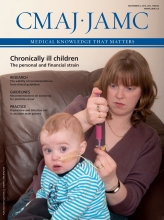See also commentary on page 1199 and at www.cmaj.ca/lookup/doi/10.1503/cmaj.141036
A study from the United Kingdom estimates that the 20-year survival for a child with a congenital anomaly varies between 66% and 97%, depending on the type of condition.1 Clearly, we should celebrate that much of this success is owing to modern pediatric care. However, many of these children survive with complex medical problems and a burdensome care situation. A study from Ontario estimated that 0.67% of families care for such a child;2 based on 2013 census data for the number of children in Canada, that translates to about 53 000 families in Canada. It is nearly impossible to comprehend the worry, work and uncertainty these families face daily.
Under the strain, many families become fragile, which puts the other children and the parents’ relationship at risk; some marriages break down under the strain. Of such situations, some say that the child survived, but the family perished. This scenario is bad for everyone concerned but, for the child with complex medical problems, the consequences are devastating. These families deserve better options.
It is curious that these families are routinely expected to cope and continue the care no matter what. Consider a family whose aged grandfather has grown ill, fragile and dependent. One of his children may undertake to care for him until the burden of his illnesses and dependency becomes too demanding. Then there are options such as home care visits, respite stays and, if needed, permanent admission to a long-term care or palliative care facility. None of this works perfectly because there are delays and restrictions, but the point is there are usually options.
And now let us consider another family, whose third child was born with dysplastic lungs. A tracheostomy tube and feeding tube are in place. Suction and oxygen are required during times of pulmonary infection. One of the parents is taught to do twice-daily chest physiotherapy. This strong family loves this child and gives much of its time, energy and money to give him the best care, while not neglecting the two older children. And that is just as well, because if any of this arrangement gives way, there are few options. Parents are expected to take the best possible care of every child, regardless of the child’s needs and the parents’ age, ability and resources. All parents are expected to make sacrifices to care for their children. But sacrifices can have some scary consequences.
The result in too many cases is personal and financial strain. Often, one parent has to quit a job to care for the child.3,4 A Canadian population-based study found that the parents of children with health conditions have more than twice the odds of having their own chronic medical conditions, activity limitations and depressive symptoms.5 Furthermore, 22.5% of them are single parents, compared with 16.3% of parents of healthy children.5
Across Canada, children with complex medical problems make up about 15% of the population receiving home care.6 In Ontario, these children receive a disproportionately low 1.7% of the funding.2,7 The programs run by foundations and disease-based interest groups are private and patchy. Coordination is poor. Services are typically based on eligibility, so that a family might be offered assisted transportation when their greatest need is for a bathroom renovation. Parents are often forced to choose between what home care there is and no care.6
Several provinces are attempting to integrate programs and improve coordination. A public program in Ontario linking a complex care program in a tertiary care hospital with local community hospitals was shown to reduce days in hospital and associated costs, not to mention stress for the child and family.8 But such programs are not the norm.
Something has to change here, but where should we start? We should start at the very beginning: with our assumption about who is responsible for the care of these children. Despite our emphasis on personal autonomy and the centrality of the family, there is interdependence among the home, community and wider society, just as there is with our aging, ailing elders. We all bear responsibility for these children and their families.6 We need to acknowledge their great unmet needs: medications, equipment, transportation, assistance at home, home care visits, access to an expert care facility closer to the family home, respite and holiday care, transition to adult care, palliative care and — yes — long-term care in an appropriate institutional setting, when the time is right, for the child and the family. These services need to be more generally available and coordinated. There needs to be more scope for families to have their particular needs assessed and to negotiate which services will be provided, rather than being told which services they are eligible for.
Footnotes
-
See references, www.cmaj.ca/lookup/suppl/doi:10.1503/cmaj.141207/-/DC1
-
Competing interests: See www.cmaj.ca/site/misc/cmaj_staff.xhtml











